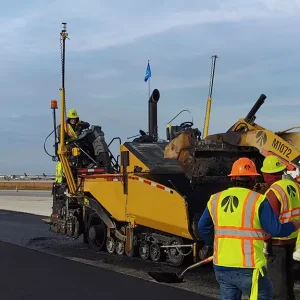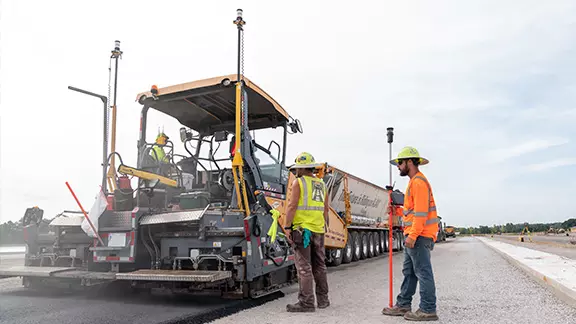
Paving Control for Asphalt Pavers
Speed up paving production while laying a smoother surface and reducing material costs.
Pave the Way to Better Profits
Productive, Integrated and Innovative
Guided by a 2D reference or 3D design model, Trimble Roadworks Paving Control Systems can help you spend less on materials and finish faster.

Horizontal Steering Control and Automatic Screed Width Control
The Horizontal Steering Control and automatic screed width control on Vögele Navitronic asphalt pavers automatically steer and control the screed width for linear paving and radius paving according to 3D design, ensuring that pavement is placed accurately horizontally and vertically, all without operator intervention.

Productive and Precise Paving
- Lay the finished surface with accuracy to 0.01 feet (3 millimeters)
- Minimize the use of expensive material
- Pave within a tighter tolerance and get closer to the minimal asphalt thickness specification
- Reduce labor costs by controlling the screed with one operator
- Reduce operator mistakes with the easy-to-use display interface
- Lay complex designs such as transitions, super-elevated curves and frequently changing cross slopes
- Achieve accuracy and smoothness specifications, which can mean a bigger bonus
Trimble 3D Paving Control in Action
Peter Brooks, paving control expert from SITECH UK/Ireland, goes onsite at a major UK road job to explain how Trimble 3D machine control systems work on asphalt pavers like those used by Aggregate Industries.
Trimble Hot Swap
Trimble Hot Swap instantly transfers total station control without the operator needing to stop the machine to make adjustments or re-calibrate.
3D Paving Control
The Trimble Roadworks 3D Paving Control Platform allows you to accurately control the screed to pave with variable depth and slope based on a 3D design.
- Take out high and low areas early in the process with the less expensive first layer materials
- Increase road smoothness while using less asphalt than with traditional paving methods
- Lay complex designs such as transitions, super-elevated curves and frequently changing cross slopes
- Achieve accuracy and smoothness specifications, which can mean bonus income
- Eliminate the time consuming and costly step of setting out stringline
Pave to a Design
- Create a 3D model in Trimble Business Center and load onto the in-cab display
- Use the SPS930 Universal Total Station and on-board software and hardware to compare the actual screed position and slope with the 3D model
- The system automatically guides the screed to lay exactly the right material thickness and slope
2D Paving Control
Trimble Roadworks 2D Paving Control Platform uses a 2D reference to pave with a fixed thickness. This makes Roadworks an excellent, lower cost option for roads that have been graded or milled using 3D paving control.
Surface Reference
Each side of the paver is typically equipped with one sonic tracer or with three sonic tracers mounted on an averaging beam. These sonic tracers send multiple sonic signals to reference off the existing surface and calculate an average elevation for paving a smooth surface.
Stringline Reference
A sonic tracer can be configured to use stringline as a reference line to control the paver. In this mode the sonic tracer will measure any lateral movement of the machine relative to the stringline. When the sonic tracer's center is moving away from the stringline, the control box warns you and provides correction guidance
Slope Sensor Reference
Trimble Roadworks can also use an angle sensor to reference the desired cross-slope of the road. Designed specifically for asphalt pavers, the sensor rarely needs recalibration and paves cross slopes of up to 0.05% accurately and consistently.
Laser Plane Reference
Use a Trimble LR410 Laser Receiver with the GL700 Grade Laser series to reference a laser plane for asphalt thickness control. Both dual and single laser receivers are supported.
